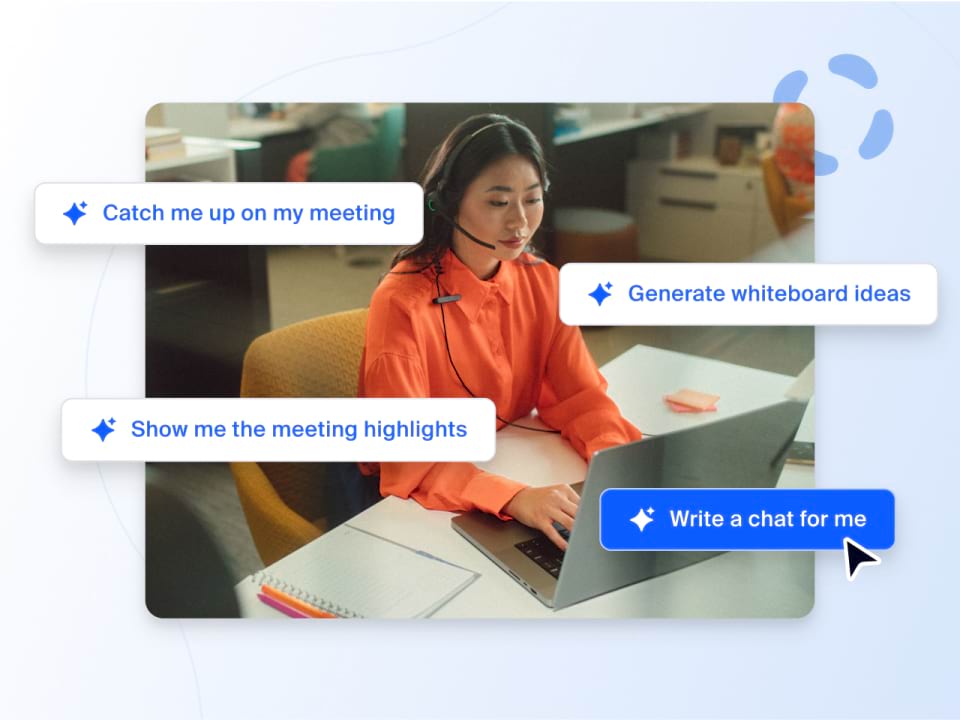Zoom commissioned a Morning Consult survey in August 2023 to understand how leaders and employees are spending their time at work, and how AI fits in. While leaders are more optimistic about artificial intelligence (and stand the most to gain from saving time with AI), employees’ mixed feelings may indicate the need for more education and support.
Solving the collaboration paradox: Survey shows how teams can save time with AI

- 01 Solving the collaboration paradox with AI - Jumplink to Solving the collaboration paradox with AI
- 02 Saving time is a top benefit of AI - Jumplink to Saving time is a top benefit of AI
- 03 Employees significantly more hesitant toward AI than leaders - Jumplink to Employees significantly more hesitant toward AI than leaders
- 04 Overcoming barriers to adoption: Companies may be holding their own teams back - Jumplink to Overcoming barriers to adoption: Companies may be holding their own teams back
- 05 Next steps: Preparing for success with AI - Jumplink to Next steps: Preparing for success with AI
Many employees spend a lot of time working in teams, but when those teams are spread out across different locations and don’t have the necessary tools, it can slow collaboration down. Collaborating from afar can result in more virtual meetings, chat messages, and other activities that fill our calendars but leave us with less time to do meaningful or effective work. These tasks are, in essence, a productivity toll: they keep us busy but don’t contribute toward productivity.
Organizations are looking to AI to help change that. Generative AI tools can help employees with a wide range of activities, from summarizing information to composing messages to automating tasks. While some companies are jumping headfirst into the generative AI boom, others are a bit more hesitant to adopt the technology.
Our AI in the Workplace report, based on an online survey commissioned by Zoom and conducted by Morning Consult,* aims to uncover some of the differences between employees and leaders in terms of sentiment toward AI, experiences, perceived benefits and drawbacks, and adoption. More broadly, the report looks at how employees and leaders are spending their workdays — and whether their most time-consuming tasks could potentially be aided by AI.
Here are a few key findings:
- Globally, leaders are more optimistic about AI than employees. Employee sentiments differ by region: those in the APAC region are more positive toward AI, while there are more mixed feelings from U.S. and European employees.
- Leaders report spending more time than employees on activities like drafting messages and taking meeting notes — tasks that could be accomplished with the help of AI.
- Leaders and employees agree on benefits but don’t worry about the same things when it comes to AI.
- Providing education and resources from the top down could potentially address employee concerns and barriers to adoption.
Read on for an in-depth look at AI in the workplace.
*Morning Consult conducted an online survey, commissioned by Zoom, of 11,023 full-time knowledge workers (8,010 employees and 3,013 team leaders) in the U.S., U.K., Ireland, Germany, France, Japan, Singapore, and Australia, between August 10–25, 2023.
Modern distributed teams need to find ways to collaborate effectively when they aren’t in the same place. But so much of collaboration involves time-consuming tasks like keeping teammates informed about what’s going on; sending updates via email, chat, text message, or project management apps; having status meetings that take time away from our ability to focus; and otherwise creating a higher productivity toll.
-
73% of leaders and 55% of employees spend at least a few times a week sharing notes and action items with colleagues
-
71% of leaders and 51% of employees provide status updates on projects to teammates and customers at least a few times a week
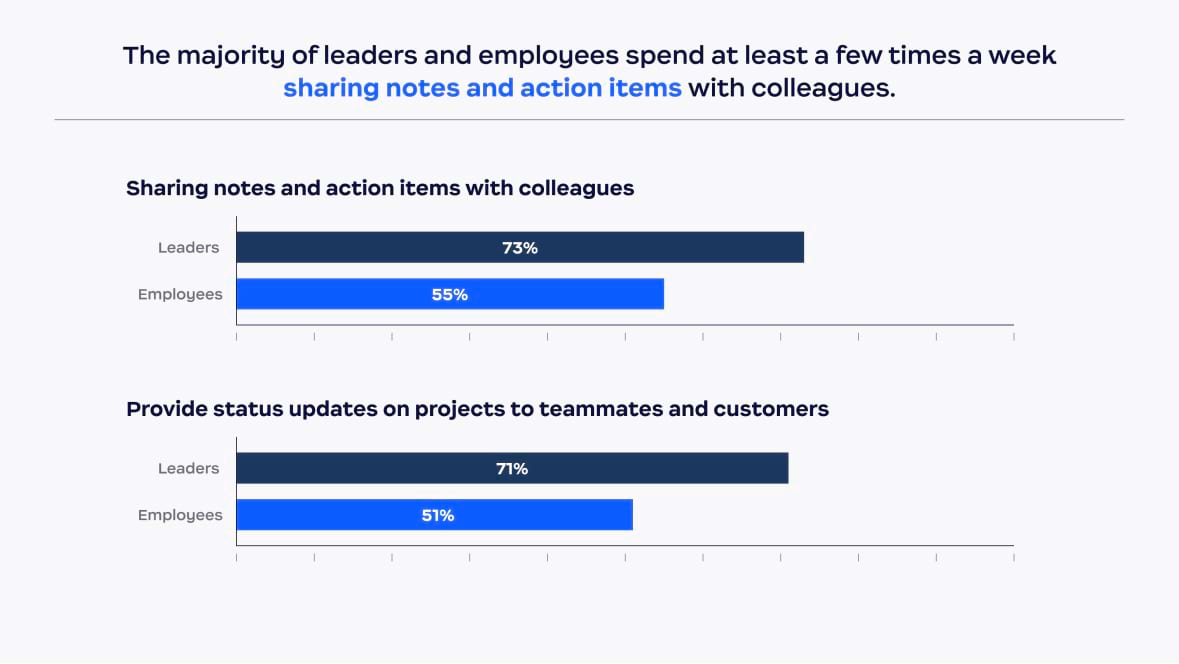
Some tasks that are required to work together effectively, like sending meeting notes or action items, can also be the very tasks that hinder effective collaboration. When teams don’t get a clear sense of what decisions have been made or are missing crucial information, they can’t move forward. At the same time, shifting priorities and a focus on execution might mean that housekeeping tasks like sending updates and action items can fall through the cracks.
While 54% of employees say summaries and action items should often or always be sent after meetings, just 39% say they are actually sent
Here lies the collaboration paradox — having to spend so much time and effort on collaboration tasks that we end up being less effective and less connected.
Just as AI can help automate or assist with tasks to improve productivity, it can also help boost collaboration. Leaders whose teams are using AI reported positive effects on collaboration. This may be because AI can be used to automate or aid in certain tasks like sharing notes and action items after meetings, composing messages, and organizing information. All these are essential for effective collaboration, but they also leave room for teams to focus on more strategic activities, decision-making, creative ideation, and other activities that move the needle.
-
75% of leaders whose teams use AI say they collaborate better
-
75% say they make better decisions
-
74% say they are able to work better when they’re not in the same location
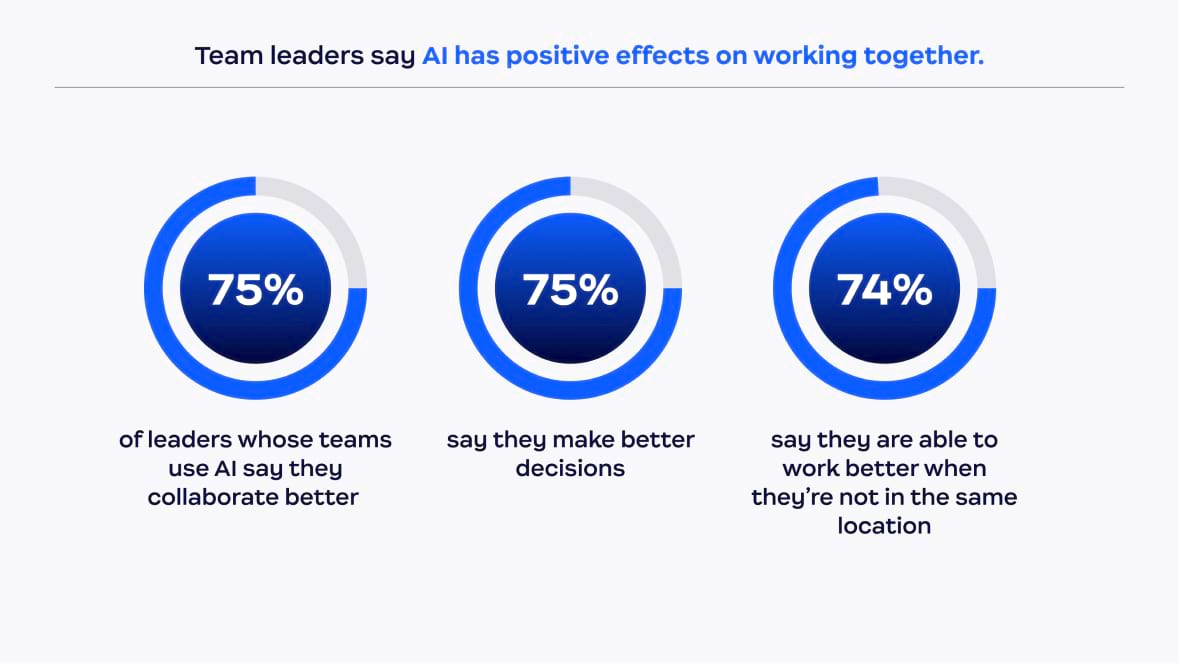
When employees and leaders were asked to identify which benefits of using AI at work were the most helpful, the top responses were related to saving time — either by reducing the number of repetitive tasks, completing work faster, or using that time for something else.
-
89% of employees identified having fewer repetitive tasks and having more time to focus on other things as top benefits of AI.
-
Similarly, 92% of leaders identified fewer repetitive tasks as a benefit of AI, along with completing work faster.
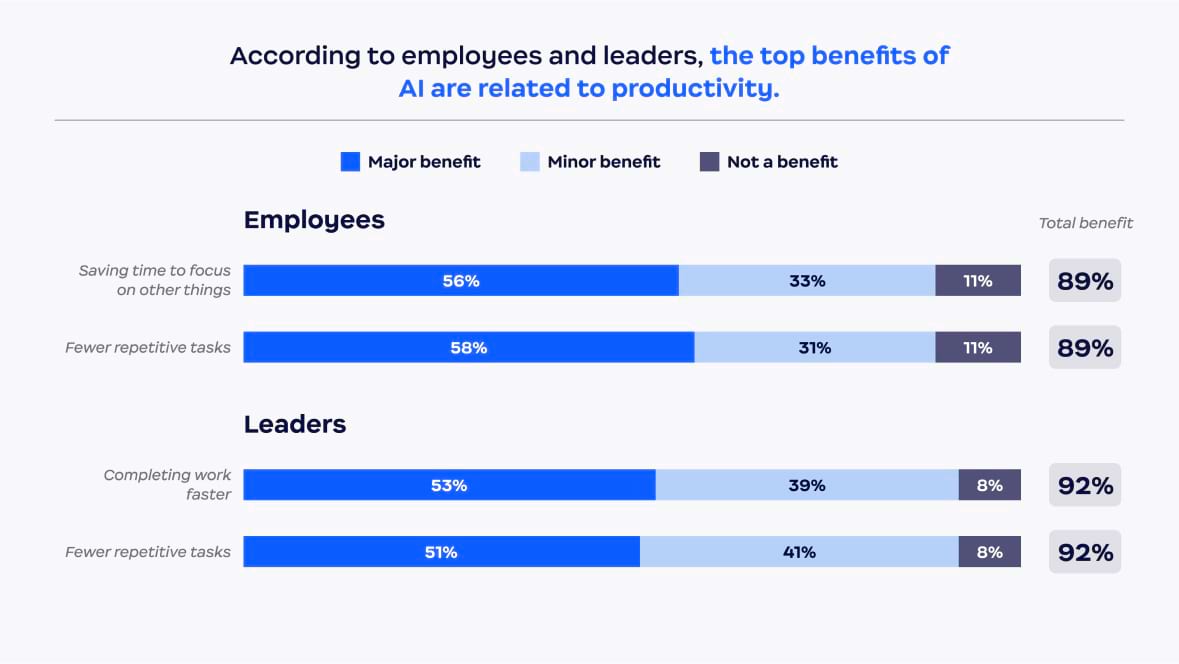
Likewise, leaders whose teams use AI at work saw similar results from the use of AI tools:
-
78% of leaders agreed their team completed tasks faster
-
77% agreed their team is more productive
-
76% agreed they delivered higher-quality work
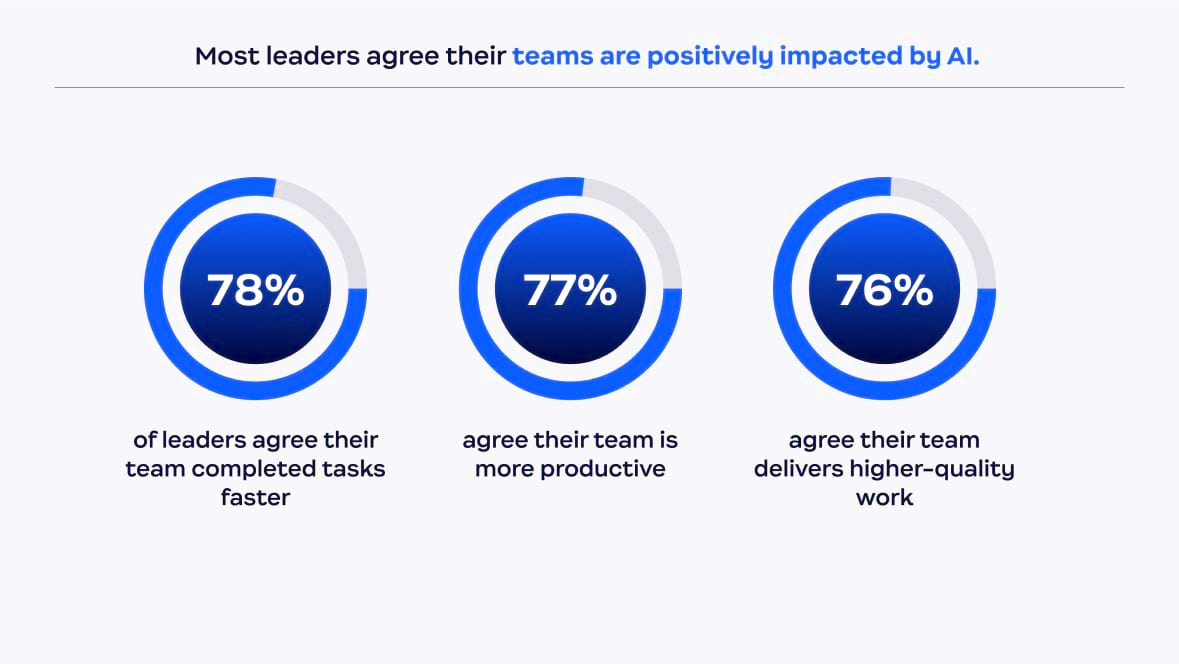
By automating or getting assistance with some of those rote tasks, employees can focus their time and efforts on more important activities that increase output, drive revenue, and otherwise move the needle — thereby improving their productivity.
While employees and leaders may agree that saving time is a great benefit, they’re split on how exactly they want AI to help them with their workday. Employees are interested in using AI tools for efficiency and automation, while leaders want to use it for assistance during and after their meetings.
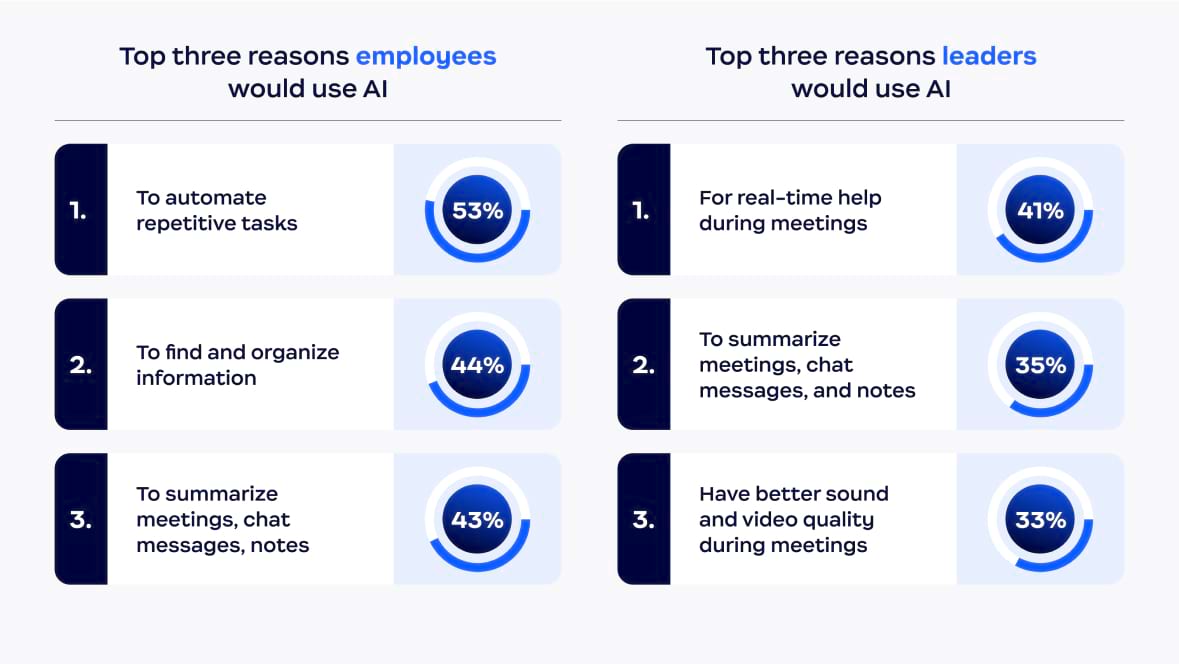
The benefit of having more time to focus on other things is borne out in the results — people who are currently using AI tools at work say it saves them time. Interestingly, leaders who use AI at work are seeing more time savings than employees: 74% of leaders say it saves them one or more hours a day, versus 46% of employees.
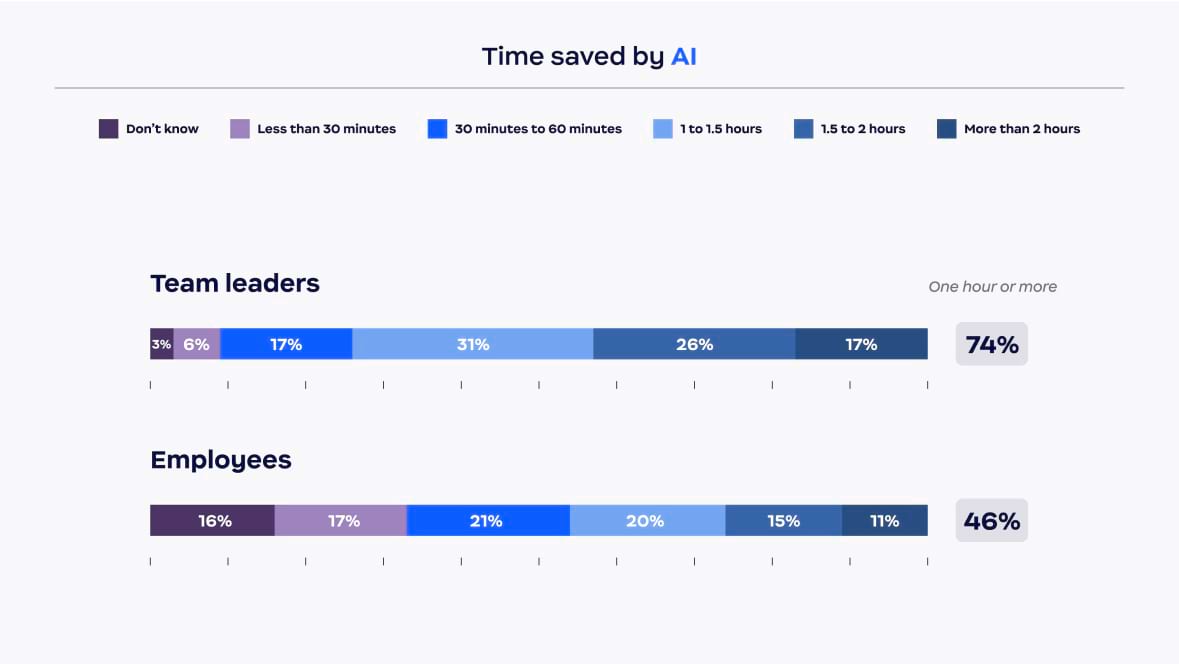
Leaders have the most to gain from saving time with AI
Leaders in particular spend a significant amount of time on rote and repetitive tasks that can be completed or aided by AI. For instance, 80% of leaders spend an hour or more a day on messages, emails, and follow-ups. Their responses indicated that they could use more time back in their day.
-
80% of leaders draft and send emails and chat messages at least a few times a week
-
54% of leaders say they spend more time on it than they want to
-
Nearly 75% of leaders take notes during meetings or share notes and action items with their colleagues at least a few times a week
-
48% of leaders say they spend more time on it than they want to
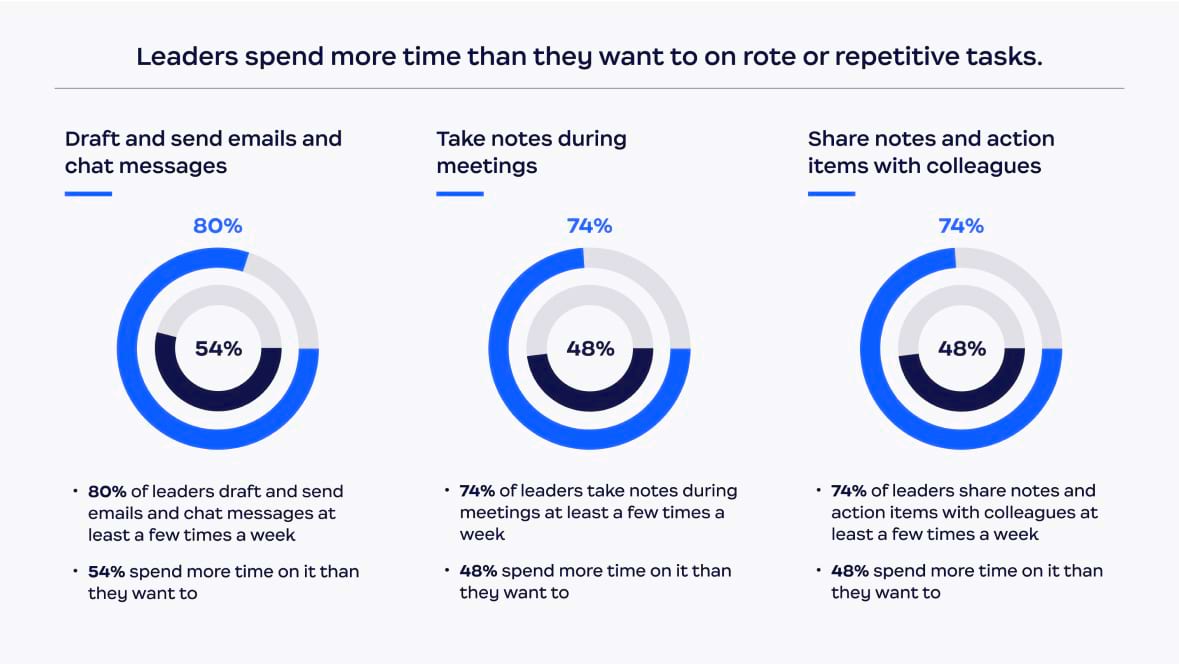
-
64% of leaders say they need more time than they have to finish all their work during the day
-
67% of leaders say they often work more than eight hours a day
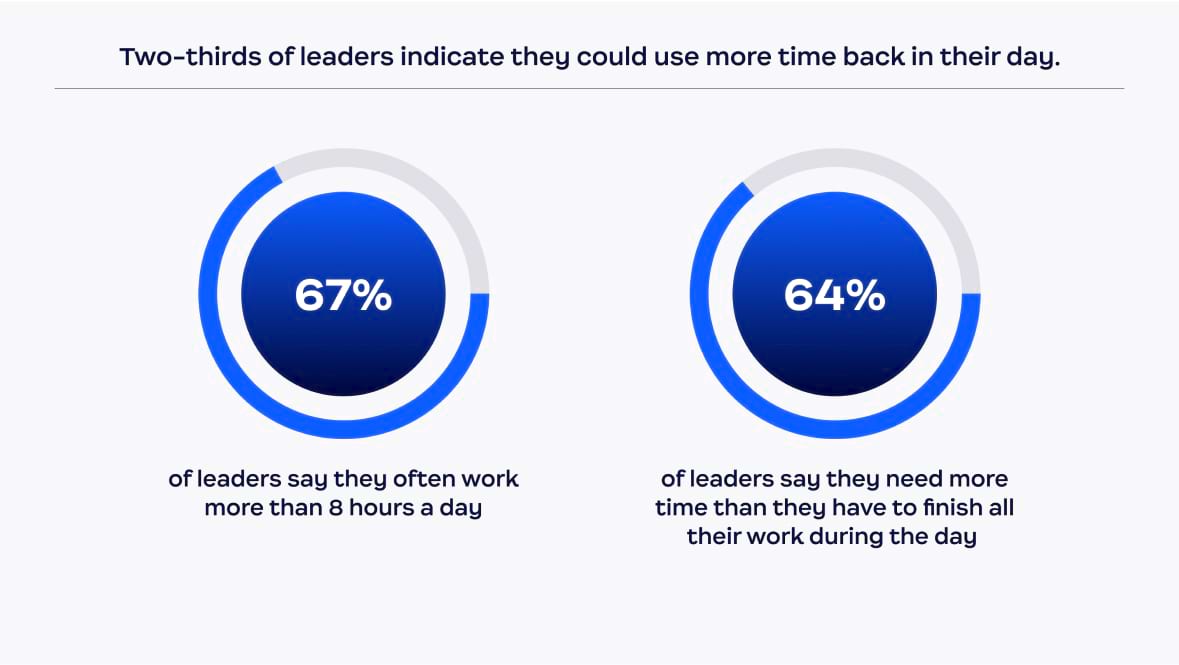
The opportunity cost being paid by AI avoiders
On the other hand, those who don’t use AI at work don’t recognize how much time they could potentially be saving.
When asked how much time they anticipated AI would save them during a typical workday, 55% of employees and 50% of leaders who don’t use AI said they didn’t know. When you compare that with what AI users say they are experiencing in terms of time saved, it’s clear that those who aren’t using it may be missing out on an opportunity to improve how they use their time.
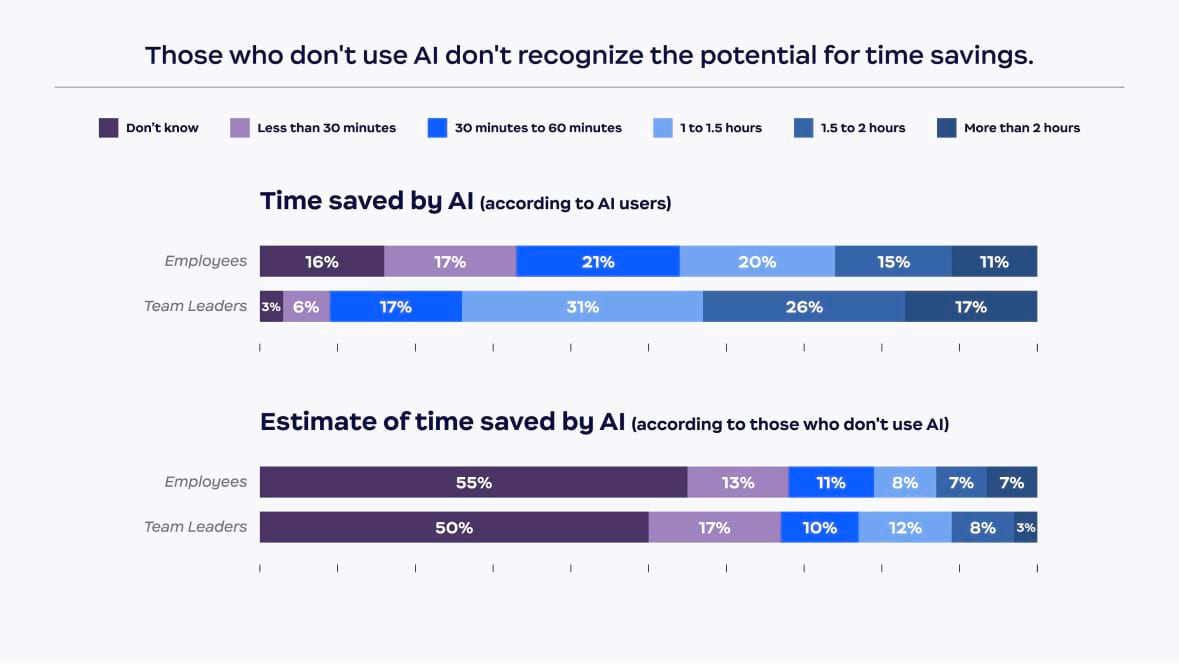
Out of those who don’t use AI, 45% of leaders and 44% of employees said they’d be likely to use it if it could save them 30 minutes per day. According to the data, it can. The majority of AI users (91% of leaders and 67% of employees) say it does save them 30 minutes or more a day. Bridging the disconnect or lack of awareness of AI’s time-saving capabilities could encourage more people to adopt it.
What would you do with more time?
Employees and leaders have similar ideas about what they would do with more time in the day, but their priorities differ slightly:
Employees
- Uninterrupted focus time to complete their work (50%)
- Developing better processes and workflows for their team (46%)
- Learning about topics relevant to their industry or career (37%)
Leaders
- Developing better processes and workflows for their team (44%)
- Learning about topics relevant to their industry or career (39%)
- Uninterrupted focus time to complete their work (38%)
There’s an overwhelming gap between leaders and employees when it comes to how familiar and excited they are about AI.
-
88% of leaders said they were favorable toward AI (with more than half of them saying they were “very favorable”), compared to 63% of employees
-
82% of leaders said they were excited about AI, compared to 57% of employees
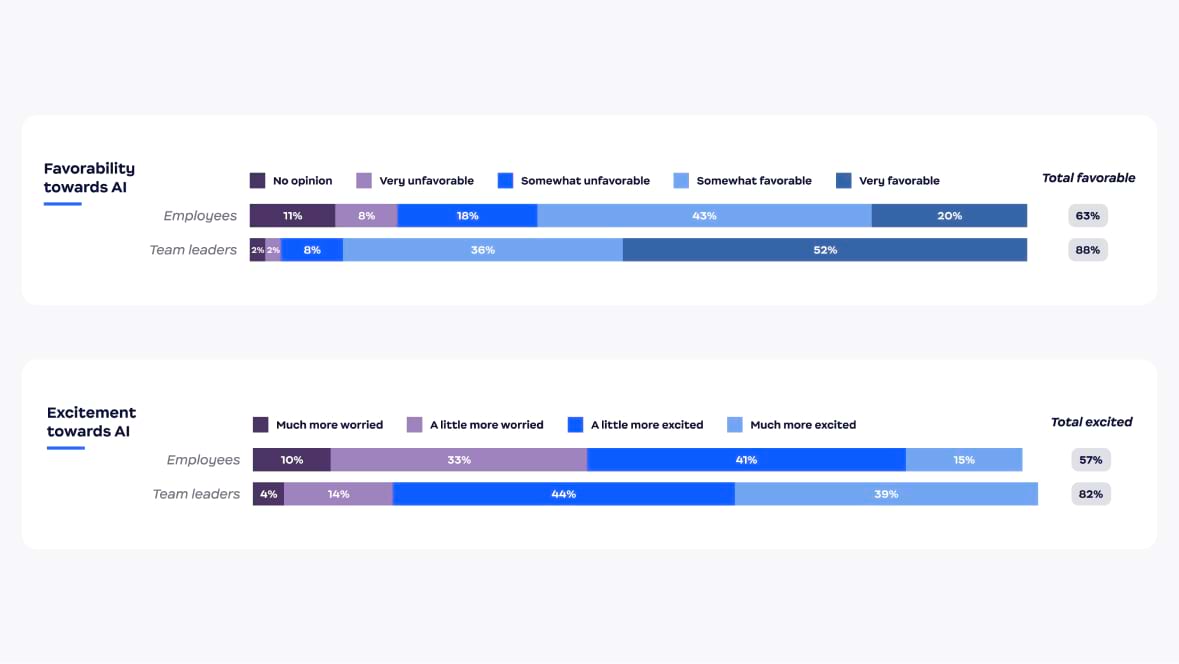
Familiarity with the technology might have something to do with it — people have to be educated about AI to embrace it and benefit from it. Leaders were much more likely to describe themselves as familiar with AI and actually be AI users.
-
90% of leaders said they were familiar with AI, with nearly half of leaders describing themselves as “very familiar.” In contrast, just 65% of employees said they were familiar with AI.
-
Leaders use AI at work at more than twice the rate of employees. 73% of leaders said they use AI at least a few times a week, compared to just 32% of employees.
-
23% of employees said they never use AI (at work or for personal use), compared to 4% of team leaders. An additional 16% of employees were unsure if they use AI at all.
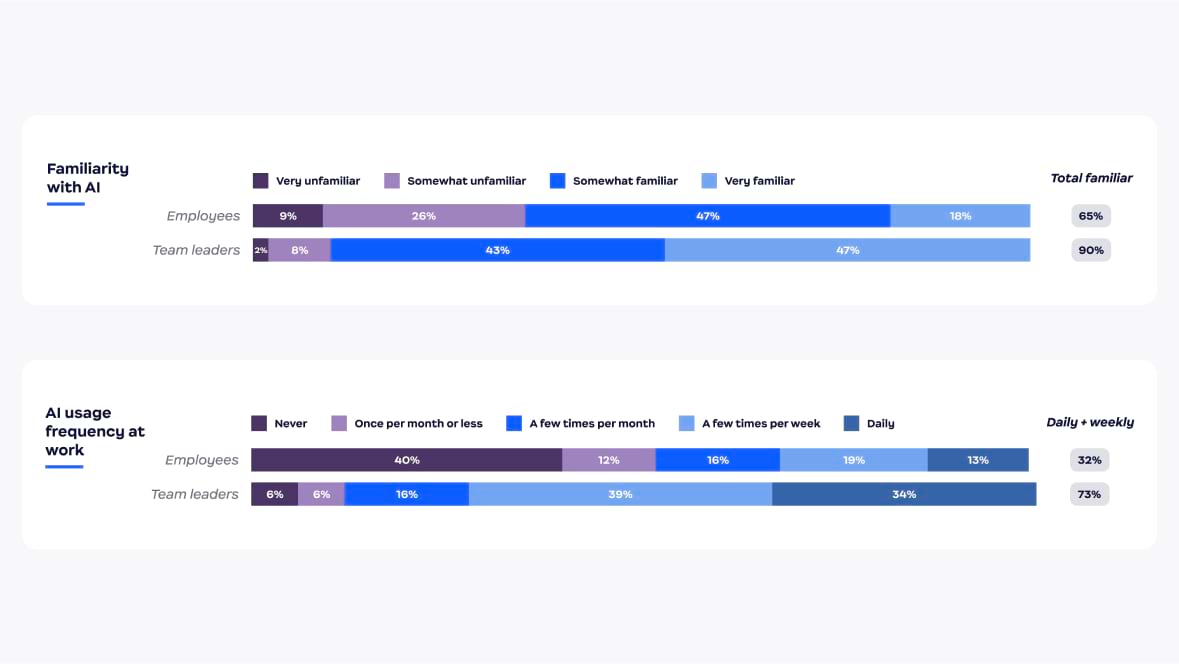
Employees, leaders split on drawbacks
It’s not surprising that as a whole, employees see more drawbacks to using AI at work than leaders. Their perceived drawbacks are related to the technology itself and the potentially negative effects it could have on their jobs — either directly or indirectly. This may indicate employees feel like they have more to lose than to gain when it comes to using AI.
- Potential of human job loss (86%)
- Company’s data being less secure (86%)
- Can’t trust its accuracy (86%)
Leaders see drawbacks to a slightly lesser degree, and their perceived drawbacks are related to employees — the effort it would take to train them and the worry that they could become dependent on it.
- Requires too much training (80%)
- Too impersonal (79%)
- Employees can become dependent on it (78%)
Among respondents who don’t use AI at work, leaders and employees were widely split on the issue of trust. Leaders were much more likely than employees to say that one of their reasons for not using AI at work is because they don’t trust it.
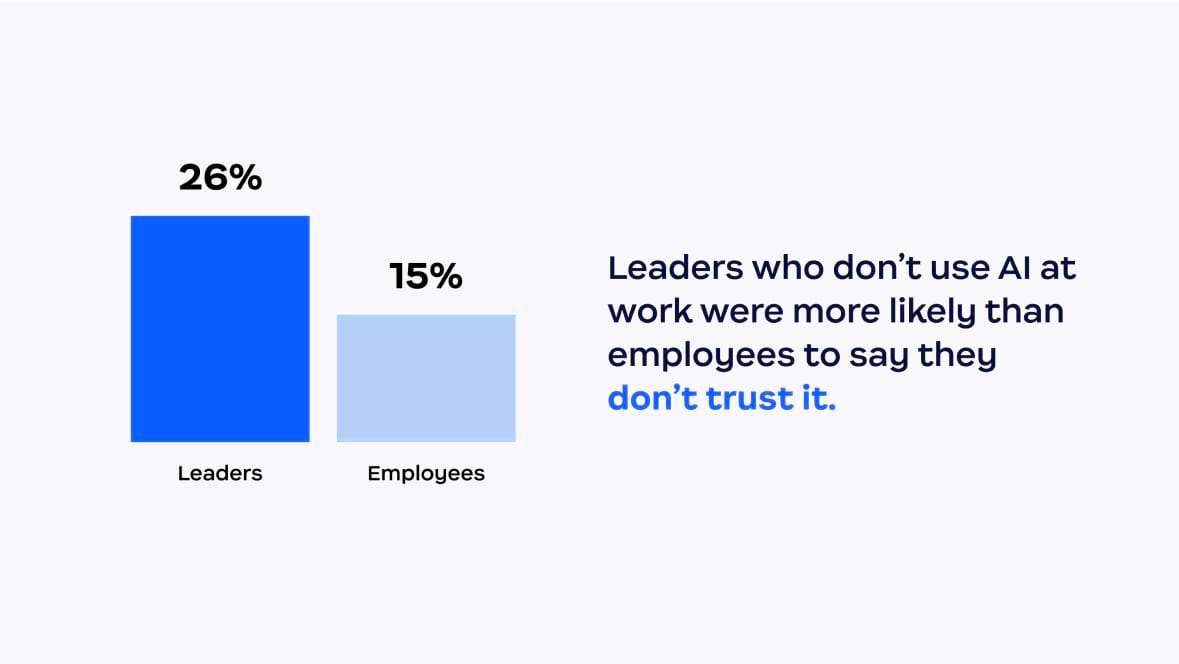
This is surprising because as a whole, leaders were more bullish on AI and its benefits. However, leaders who don’t use AI at work were overwhelmingly more conservative on AI’s benefits and more likely to see major drawbacks than their counterparts who do use AI at work.
Attitudes toward AI vary globally
Employees in the Asia-Pacific (APAC) region had more positive sentiments toward AI overall. Countries in Europe and the U.S. showed similar favorability with 57% of European employees and 56% of American employees indicating they were favorable toward AI. Employees in France stood out as having the lowest level of favorability at 51%, with 37% indicating they felt somewhat or very unfavorable toward AI.
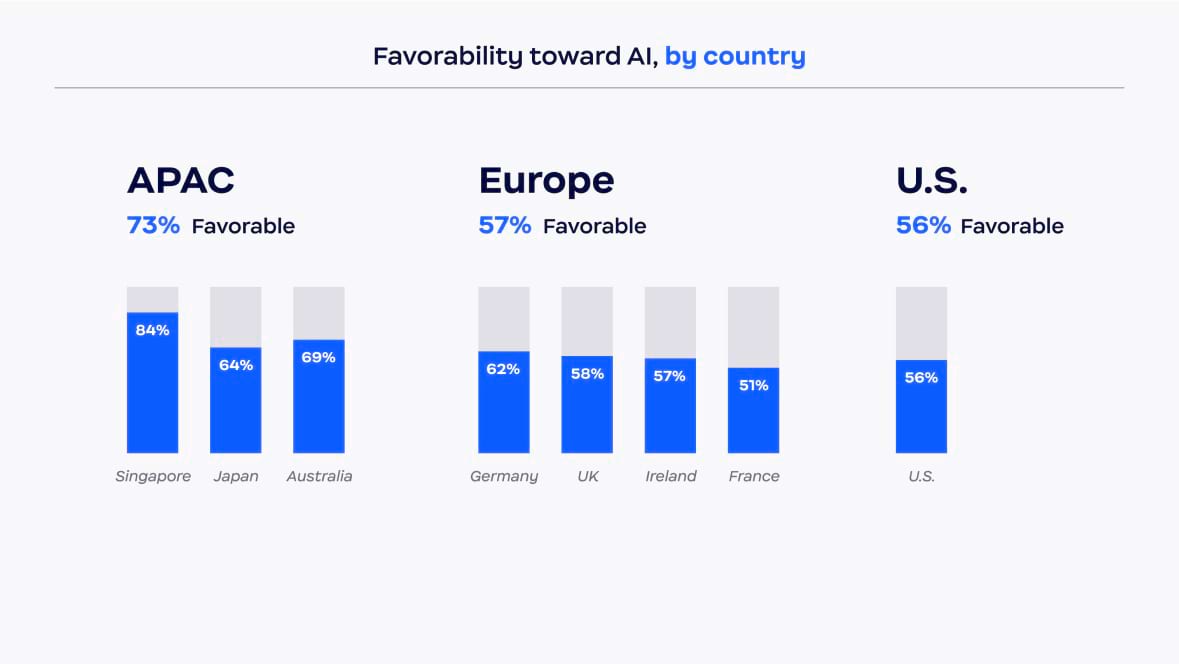
Results were similar in terms of feeling excited about AI — APAC countries in general showed more excitement. U.S. employees showed more mixed feelings, with 47% indicating they were excited about AI, but French employees were the least excited at 42%. Since 51% of employees in France rated AI favorably, this might show that some employees see AI as an overall positive force but are ambivalent about using it.
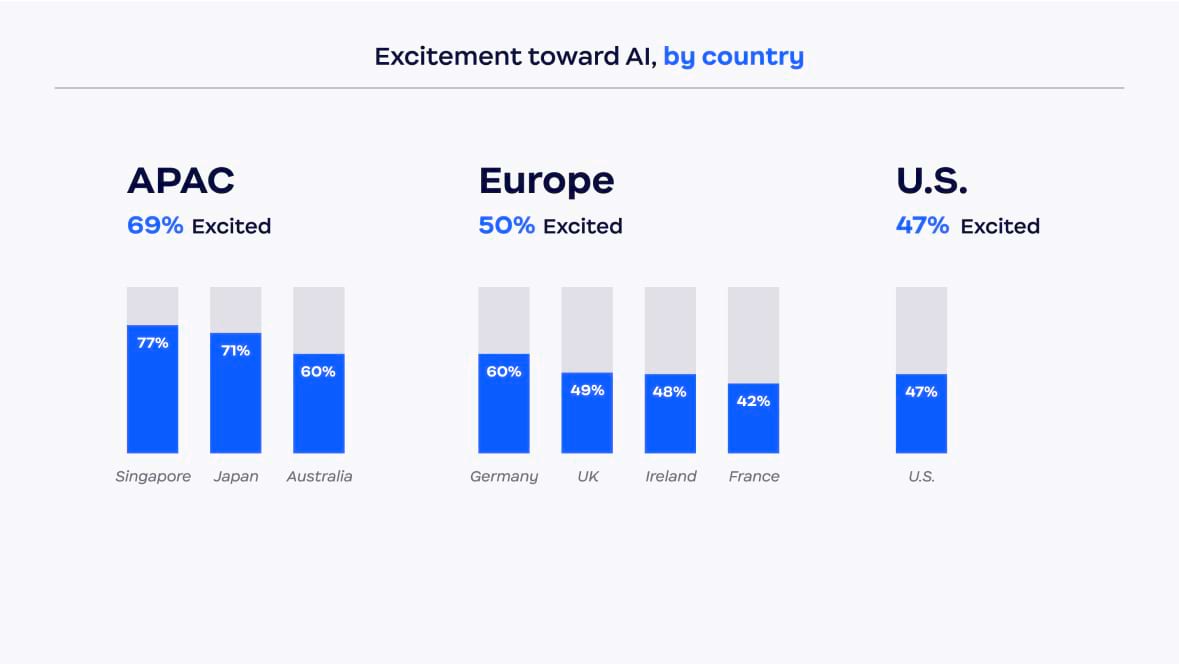
If the majority of respondents agree that using AI saves time (90%), leads to fewer repetitive tasks (90%), and results in fewer mistakes (89%), then what’s holding teams back from using AI?
Among those who said they don’t use AI at work, slightly more than half said it’s because their company as a whole doesn’t utilize it. Many employees may be hindered by their companies not providing tools and opportunities to incorporate AI into their work.
Of those who do use AI at work, 63% say their company provides AI tools — meaning the other 37% need to be self-motivated to seek out these tools.
Other common reasons included not being familiar with it and not knowing how it could help them with their work, pointing to a need for further education for employees.
Despite having an overall positive view of AI, leaders recognized potential barriers to adoption that pointed toward a need for training and enablement.
-
71% of leaders say a barrier to their team using AI is because their team is used to working a certain way
-
69% say their team wouldn’t know how to use it
-
67% say it’s because their team isn’t savvy with technology

85% of leaders believe at least some training of AI benefits is needed at their company, validating the importance of educating employees about AI. However, as mentioned previously, leaders identified a top drawback of AI was that it requires too much training (80%).
In taking a closer look at training and resources currently available for those who use AI at work, leaders and employees had differing views. 86% of leaders said their organization provided some to a lot of resources on how to best utilize AI, compared to just 60% of employees.
This disconnect indicates that leaders are aware of resources being created but employees may be unaware of the resources available to them. Improving communication with employees and providing better access to resources could help close the gap and support AI adoption.
Leaders felt other barriers to adoption could be related to employee fears about AI: worries that it will take their job (70%), or that they don’t trust AI (69%). This uncovers an opportunity to address potential fears through education, but it also points to the need for leaders to provide a framework that will help employees use AI effectively to overcome those barriers.
Training and education should focus in part on showing employees how AI can help automate or enhance certain parts of their job, leaving them with the time and bandwidth to focus on tasks that require a human touch. Organizations should also address concerns about trust by showing employees that issues like data privacy and handling, AI bias, and security, are top of mind when evaluating any AI tool.
As with any new technology, organizations should carefully evaluate AI tools and create a plan or framework for implementing them effectively. Rushing to incorporate AI without considering its inherent risks or how it will affect employees may result in low adoption, security and privacy issues, and other negative effects.
At the same time, organizations need to avoid delaying for too long — 71% of leaders surveyed agreed that those who don’t introduce AI to their teams risk getting left behind. Companies taking a wait-and-see approach may find themselves being overtaken by early adopters who are reaping the benefits of improved productivity, collaboration, and employee effectiveness.
Our companion piece, “AI at Work: Enhancing Employee Engagement and
Business Success,” developed by Harvard Business Review, will help you prepare your organization to implement and embrace AI technologies. Get insights from leading AI and digital transformation experts on how you can develop an employee experience that promotes education, training, and effective use of AI.

Save time with your smart AI assistant
Zoom AI Companion empowers you to be more productive, collaborate better, and enhance your skills. Included at no additional cost with the paid services in your Zoom user account.*
*AI Companion may not be available for all regions and industry verticals.
